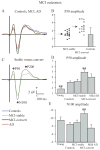Auditory system dysfunction in Alzheimer disease and its prodromal states: A review
- PMID: 29630950
- PMCID: PMC9664450
- DOI: 10.1016/j.arr.2018.04.001
Auditory system dysfunction in Alzheimer disease and its prodromal states: A review
Abstract
Recent findings suggest that both peripheral and central auditory system dysfunction occur in the prodromal stages of Alzheimer Disease (AD), and therefore may represent early indicators of the disease. In addition, loss of auditory function itself leads to communication difficulties, social isolation and poor quality of life for both patients with AD and their caregivers. Developing a greater understanding of auditory dysfunction in early AD may shed light on the mechanisms of disease progression and carry diagnostic and therapeutic importance. Herein, we review the literature on hearing abilities in AD and its prodromal stages investigated through methods such as pure-tone audiometry, dichotic listening tasks, and evoked response potentials. We propose that screening for peripheral and central auditory dysfunction in at-risk populations is a low-cost and effective means to identify early AD pathology and provides an entry point for therapeutic interventions that enhance the quality of life of AD patients.
Keywords: Audiometry; Auditory cortex; Dichotic; Evoked potential; Mild cognitive impairment.
Copyright © 2018 Elsevier B.V. All rights reserved.
Figures


References
-
- Agrawal Y, Platz EA, Niparko JK. Risk factors for hearing loss in US adults: data from the National Health and Nutrition Examination Survey, 1999–2002. Otol Neurotol. 2009;30:139–145. - PubMed
-
- Aimoni C, Prosser S, Ciorba A, Menozzi L, Soavi C, Zuliani G. Speech audiometry tests in noise are impaired in older patients with mild cognitive impairment: a pilot study. J Int Adv Otol. 2014;10(3):228–233.
-
- Alain C, Zendel BR, Hutka S, Bidelman GM. Turning down the noise: the benefit of musical training on the aging auditory brain. Hear Res. 2014;308:162–173. - PubMed
-
- Anstey KJ, Luszcz MA, Sanchez L. A reevaluation of the common factor theory of shared variance among age, sensory function: and cognitive function in older adults. J Gerontol B Psychol Sci Soc Sci. 2001;56:3–11. - PubMed
-
- Bennys K, Portet F, Touchon J, Rondouin G. Diagnostic value of event-related evoked potentials N200 and P300 subcomponents in early diagnosis of Alzheimer's disease and mild cognitive impairment. J Clin Neurophysiol. 2007;24:405–412. - PubMed
Publication types
MeSH terms
Grants and funding
LinkOut - more resources
Full Text Sources
Other Literature Sources
Medical

